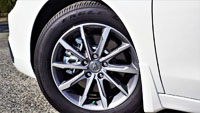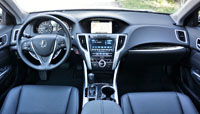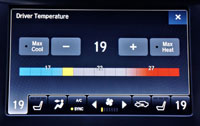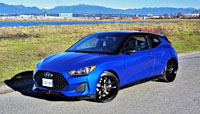
Hyundai’s Veloster could easily be seen as an automotive anomaly, a sports coupe cum four-door hatchback that doesn’t quite fit in to either category, but I see it as a best-of-both-worlds alternative, a sporty two-door coupe when seen from the driver’s side and a low-slung four-door liftback from the passenger’s side.
There’s good reason that such a small number of volume-branded compact sport coupes remain in today’s car market after all. Owners eventually tired of stuffing family and friends into their abbreviated back seats, so they purchased sporty four- and five-door alternatives instead. These days, even the legendary VW Golf GTI is only available with four doors and a hatch, but instead of ultimately conforming to such wagon-like levels of pragmatism, Hyundai adapted General Motors’ 1999 Saturn SC’s terribly executed yet brilliantly idea, which included a single door on the passenger’s side and a second rear-hinged half-door on the driver’s side for easier rear seat access, by adding a conventionally-hinged rear door to the more appropriate passenger’s side for easier entry from the curb.
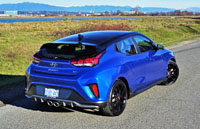
During its first full calendar year of 2012, Canadian Veloster sales were fairly strong at 5,741 units, but they’ve steadily tapered off since resulting in a low of 1,077 units in 2018, but thanks to a total redesign for this 2019 model year the second-generation Veloster has found 36.6 percent more buyers than it did during the first 10 months of 2018, resulting in 1,295 deliveries as of October 2019. Still, that’s nothing to get excited about in a market that saw Hyundai sell 25,894 Tucson compact SUVs during the same time period, let alone 33,670 Elantras, while a recent downturn of just 279 Velosters sold during Q3 of 2019, representing a plunge of 55.1 percent compared to the same three months of 2018, isn’t the kind of response the brand wants to see for a completely redesigned model, so we’ll need to watch closely to find out how it fares during Q4.
Before Hyundai decides to transform the Veloster into a mainstream version of Mercedes’ new GLC Coupe in order to keep its sporty dreams alive while the entire globe realigns its interests away from cars towards crossovers and SUVs (kind of like how Mitsubishi did with its Eclipse Cross), those who still appreciate the lower centres of gravity and inherently better cornering prowess allowed by cars should be made aware of the new Veloster’s transformation from a torsion beam rear suspension to an independent multi-link design, the revision completely improving its at-the-limit handling and ride quality.
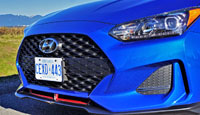
The updated Veloster’s undercarriage is much more compliant, resulting in a more comfortable city cruiser with less commotion over rough, uneven tarmac, yet the compact coupe still feels firm enough to come off like a sports car. Nevertheless, despite its more comforting suspension tuning the new Veloster Turbo is a lot more capable through fast-paced corners, particularly noticeable over mid-apex bumps and potholes that would’ve unsettled the previous car. Now you slice through the turn with less worry about the shape of the pavement below, its rear suspension now capable of absorbing such irregularities without losing grip.
Base Velosters come standard with a 2.0-litre four-cylinder engine making 147 horsepower and 132 lb-ft of torque, driving the front wheels through a standard six-speed manual or optional six-speed automatic transmission, while the Veloster Turbo tested here utilizes a 1.6-litre turbo-four capable of 201 horsepower and 195 lb-ft of torque. A six-speed manual gearbox remains standard, as witnessed here in the photos, but buyers wanting less daily hassle can opt for a new seven-speed dual-clutch EcoShift DCT automatic with steering wheel paddles. I’ve driven the previous six-speed DCT (in 2014, 2015 and 2016) and found it shifted quickly enough while offering smooth operation during day-to-day commutes, so it make sense the new seven-speed version provides the same level of drivability with the addition of a taller final gear to improve fuel economy, but I’d personally save $1,500 by opting for the manual and enjoy the benefits of rowing through the gears myself.

It really is a nicely sorted six-speed manual, with an easy, progressive clutch that’s well matched to the torquey turbo-four. Max twist arrives at just 1,500 rpm and maintains boost all the way to 4,500, while maximum thrust arrives at 6,000 rpm before the engine spins to its 7,000 rpm redline (or just above). Activating the optional “SPORT” button just next to the shift lever immediately transforms the Veloster Turbo from an enjoyably tame economy coupe to a seriously fun performance machine, so a move up to the Tech package is well worth it.
Before itemizing standard and optional features, we should talk fuel economy. I know the Veloster is a performance model, but even those looking to save at the pump might want to consider this sporty little car, especially the Turbo. Yes, despite its stronger performance the Turbo is better on fuel (as long as you don’t lay into the throttle too often), with a manual transmission comparo showing 9.4 L/100km in the city, 7.0 on the highway and 8.3 combined for the Turbo, next to 9.4 city, 7.1 highway and 8.4 combined for the base model. The Turbo looks even better when comparing automatic transmissions, at 8.5 city, 6.9 highway and 7.8 combined for the quicker car against a respective 9.1, 7.1 and 8.2.
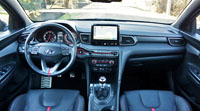
Now that we’re being so practical, the rear tailgate opens up nice and high, plus it’s wide enough to fit in large items. The cargo area isn’t as sizeable as most of its compact hatchback rivals, but compared to challenging sport coupes it’s very accommodating. In fact, it measures 565 litres (20 cubic feet) behind the rear seatbacks, or approximately the size of a large sedan’s trunk, while it’s also 125 litres (4.4 cu ft) larger than its 440-litre (15.5 cu-ft) cargo compartment. If you need more storage you can drop the back seats down, their uniquely configured 66/33-split design making more sense for a car only capable of seating two rear passengers. With both seats lowered the Veloster can manage up to 1,260 litres (44.5 cu ft) of what-have-you, which once again is a major improvement when compared to the 982 litres (34.7 cubic feet) offered by the outgoing generation.
The lengthy driver’s door and proximity keyless access make entering to the driver’s seat easy, while the two passenger-side doors means that no one coming along for the ride needs to compromise. Certainly, the first rear passenger to sit down must slide along the seat to find the other side, making me wish Hyundai hadn’t added a fixed centre console with cupholders in the middle, and while a folding centre armrest would’ve worked better, it wasn’t all that difficult to get over and does provide some helpful convenience when seated.

After positioning the driver’s seat for my five-foot-eight, long-legged, short-torso body, I was left with approximately four to five inches in front of my knees, as well as plenty of space for my feet, but it was a bit tight for my toes below the driver’s seat. Still, I had ample room to move around from side to side, plus about three inches over my head, making me confident that those under six feet should find it spacious enough in back.
The rear seats are carved out like buckets too, providing decent lateral support and good lower back comfort. Other than rear window switches there aren’t any rear amenities, while the side armrests will be the only padded surfaces you’ll be able to find (seats and carpets aside).
Such is true for those up front as well, this shortcoming my only serious complaint with the new Veloster. I understand that we should expect too much in this category, but Hyundai normally punches above its weight in the compact class, so I expected them to do more with this redesigned model. As it is, the new Veloster offers no soft-touch composite surfaces, but the mostly attractive matte textured plastics provided a nice upgrade over the otherwise glossy hard plastic cabin.
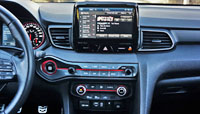
Most peoples’ eyes will naturally gravitate to the red on black front sport seats anyway, and I must say the one for the driver was as comfortable and supportive as it looks. While not included full powered actuation, its optional two-way powered lumbar support was a useful addition that nearly met the small of my back perfectly. Ergonomics are also good, with the long reaching tilt and telescopic steering column a good match to the six-way adjustable driver’s seat, plus the seat heaters and warming steering wheel came on fast and stayed hot.
Quickly pressing the start/stop button on the instrument panel ignites the engine while prompting a head-up display to power upwards from within the cowl covering the primary gauges. I initially found it slightly distracting, because it’s right in the line of sight, but when choosing sport mode it placed a cool tachometer graphic on the screen that was useful when pushing the engine to redline, while I eventually learned to look past it the rest of the time. The mostly analogue gauge cluster noted a moment ago is easy to see in any light and features a colour multi-information display at centre, while the switchgear on the steering wheel, plus all the buttons and knobs to the left and right of the steering column were good quality, nicely damped, and within easy reach.
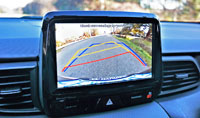
Ditto for the infotainment display, but the only button next to the screen turned on the hazard lights. Instead, the touchscreen’s analogue controls are lower down the centre stack, in between the audio system’s power/volume and tuning/scrolling dials, although I found myself using the steering wheel switches and touchscreen for the majority of features.
Due to Hyundai adding the $3,000 Turbo Tech package, which includes the aforementioned head-up display unit, the leather upholstery, the driver’s seat lumbar support, and the Sport mode, plus rain-sensing windshield wipers, rear parking sonar, and the automatic HVAC system, which incidentally comes with automatic defog, my tester had a larger 8.0-inch display featuring embedded navigation plus excellent (for the class) sounding eight-speaker Infinity audio with an external amplifier.
Before getting ahead of myself, you can get into the 2019 Veloster for just $20,999 plus freight and fees before discount, with the Turbo starting at $25,899. The Turbo Tech package ups the price to $28,899, while a $500 Performance package was added to my tester, including sportier 18-inch rims encircled by 225/40 Michelin Pilot summer-performance rubber.
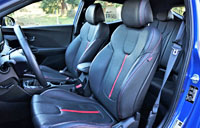
This said, even base Velosters get 18-inch alloy wheels, as well as auto on/off headlamps, LED daytime running lights, power-adjustable and heated side mirrors, remote access, a heated and leather-wrapped multifunction steering wheel, tilt and telescopic steering, cruise control, powered windows, illuminated vanity mirrors, a sunglasses holder, filtered air conditioning, a one-inch smaller 7.0-inch infotainment touchscreen with standard Android Auto and Apple CarPlay, a backup camera with active guidelines, six-speaker audio, Bluetooth hands-free phone and audio streaming, a leather-clad shift knob, heatable front seats, a manual six-way driver’s seat, a four-way front passenger seat, blind spot detection with rear cross-traffic alert, all the usual active and passive safety features, etcetera.
The Veloster Turbo upgrade adds LED headlamps, LED side mirror turn signals, LED tail lamps, a special grille plus extended side sills, proximity entry with pushbutton star/stop, a 4.2-inch TFT multi-information display instead of a more conventional 3.5-inch trip computer, a big power moonroof, silver vent bezels, checkered dash trim, partial cloth/leather upholstery with red stitching instead of blue, leatherette door trim, red interior accents, plus more.
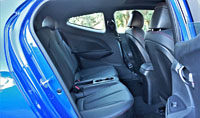
I could go into colour options and more, but considering this 2019 model is being replaced by the 2020 version while this review is being published, you’ll have to get what you can if wanting to avail model year-end discounts as well as 0-percent financing (the 2020 model was available with 0.99-percent financing at the time of writing). By the way, you can learn about these deals and more right here at CarCostCanada, where all trim, package and individual option prices are itemized, as well as manufacturer rebate info and otherwise hard to get dealer invoice pricing that could save you thousands.
If you like the idea of the new Veloster but were hoping for more performance, you may also want to consider new N trim. It includes a new 2.0-litre turbo-four with 275 horsepower and 260 lb-ft of torque, and comes exclusively with a six-speed manual featuring downshift rev matching. An electronically controlled limited slip differential helps put the power down to the pavement, while an electronically controlled suspension support a big set of 19-inch alloys on 235/35 Pirelli summer-performance tires. Also included are Normal, Sport, N and Custom drive mode selections, while a driver-adjustable active exhaust system makes this ultimate Veloster even more exciting to drive. Even its fuel economy is decent at 10.6 L/100km city, 8.3 highway and 9.5 combined, while it starts at just $34,999.

Notable when comparing 2019 to 2020 Velosters, the new base model won’t be available with a manual transmission anymore, which will only cause performance purists and custom tuners to feel a bit miffed. This change causes the 2020 Veloster’s base price to go up by $1,400 to $22,399, with the cheapest manual now the $27,499 Turbo.
Also important to note, Hyundai has modified its trim naming scheme for 2020, eliminating the GL and Tech designations from the 2019 model while adding Preferred and Luxury to the 2020. The 2020 Veloster N remains a single-trim car for the same price, although those searching for it on CarCostCanada will need to choose it as a separate model from the regular Veloster line.
Whether opting for a 2019 or 2020 model, an old GL, Tech or N, or the new Preferred, Luxury or N trim, the new second-generation Veloster is a much more advanced car than its predecessor. It still combines an extremely sporty look with a very practical layout, but now mixes in stronger performance, newer electronics, and new features, resulting in one of the smartest urban runabouts currently available.
Story and photo credits: Trevor Hofmann



